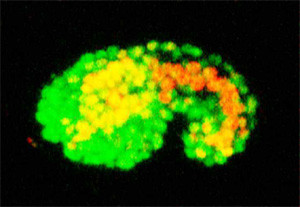
Mapping Gene Expression to Single Cells
We are constructing new worm strains that allow us to study the genetic framework of embryonic development. By collecting images throughout embryonic development and analyzing them with StarryNite, we are able to reveal the expression of genes at the level of individual cells. The data below was generated using a worm strain with universally expressed histone:GFP to label each nuclei and a histone:RFP (red fluorescent protein) under the control of the regulatory region of pha-4, a gene required for digestive tract development.
RFP Gene Expression Driven by a pha-4 Regulatory Sequences.
In this movie, the 3D images of the embryo are shown as the embryo develops from the 4-cell stage to a larva. In addition to the histone:GFP, this worm strain has histone:RFP driven by regulatory sequences from upstream of the gene pha-4, a transcription factor expressed in the pharynx, gut, and rectum that regulates development of structures within the worm digestive tract.
Here, the MS lineage adopts a cell division and gene expression pattern similar to the E lineage after the function of pop-1, a gene required to specify MS identity, is knocked down using RNA interference.
Again, cells expressing RFP driven by a pha-4 promoter are shown in red.
Cells expressing RFP driven by a pha-4 Promoter.
Cells expressing RFP driven by the pha-4 regulatory sequence are shown in red.